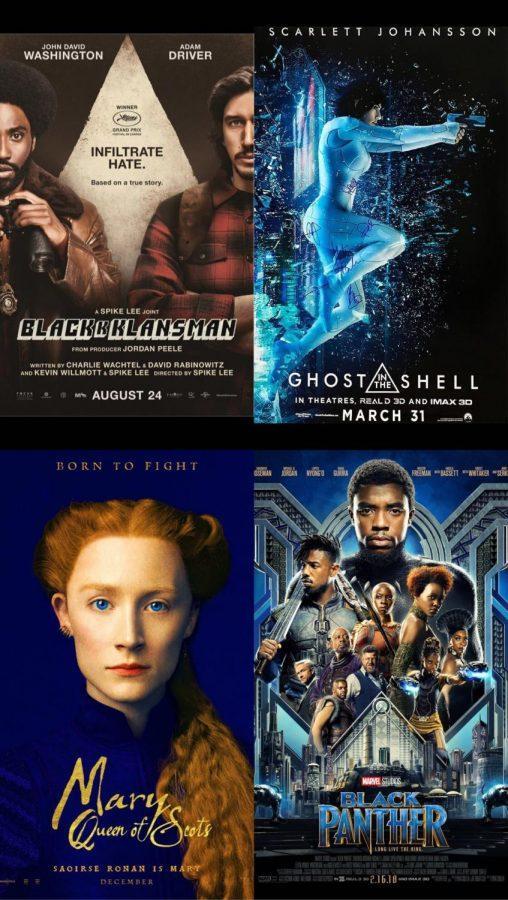Fishing for ‘Bait’ Amid Oscar’s Diversity Push
The push for diversity within Hollywood may be redefining the nature of “Oscar bait.”
Courtesy of Focus Features, Paramount and Marvel Studios
Movie posters for “The BlacKkKlansman,” “Ghost in Shell,” “Black Panther,” and “Mary Queen of Scots.”
September 17, 2018
Ninety years, 84 percent white, and 69 percent male — this is the current makeup of the Academy of Motion Picture Arts and Sciences after inviting a record 928 members this past June. Notorious for its historical lack of diversity and representation of minorities, the Oscars has been undergoing mild changes in recent years after facing criticism for its failure to recognize women and people of color in the film industry.
Movements such as #OscarsSoWhite emphasize the lack of diversity in nominees and winners; highlighting how, for almost a century, actors, writers and filmmakers of color have been overlooked at awards shows. Only five Hispanic-Americans, the largest minority group in the United States, and only two Asian-Americans have ever won an Oscar. This statistic excludes winners like Javier Bardem and Penelope Cruz, who are both Spanish citizens. It also excludes Alfonso Cuarón and Alejandro González Iñárritu, both past winners for best director, because they are Mexican nationals.
“In the past, the lack of diverse nominees has been an issue,” Tisch first-year Joshua Lelonek said. “It speaks to a larger issue of institutionalized racism that there had to be a movement to correct it. It’s interesting to think about whether the change came from our genuine interest of correcting the problem or trying to control a press sh-tstorm.”
The Academy slowly widens its narrow lens, but aside from the actors, what effect is this having on the movies themselves? Many Oscar-winning movies — past and present — have been tagged as “Oscar bait,” a term used by the industry to denote movies that have been solely made with the intent to receive a prized golden statuette. These bait movies are released shortly before Oscar season, so they’re fresh in viewers’ minds. Take “The Danish Girl” (2015), “The Blind Side” (2009) and “The Imitation Game” (2014) — they all dangled in front of the Academy’s face, and it took the bait.
But with steps being taken to include and represent minorities in movies and awards shows, there has been a shift in what “Oscar bait” movies are. Viewers are no longer content to contribute to box office funds for conventional all-straight, all-male, all-white films. Now, Oscar bait movies are seemingly required to have at least one leading actor of color to even be considered for an Oscar.
“Whitewashing in Hollywood is a huge problem, too,” Steinhardt first-year Wil Ren said. “A lot of white actors, for instance, will play Asian roles.”
Indeed, the whitewashing in Hollywood has been excessive. Most notably in recent years, actresses such as Scarlett Johansson and Emma Stone have been cast as Asian characters, meant to pass as ethnicities which the do not belong to. Johansson’s 2017 film “Ghost in the Shell” almost used CGI on her to make her appear East Asian rather than simply cast an East Asian actress.
Many feel that movies featuring either an all-male cast, an all-white cast or both are not “Oscar-worthy” anymore — how can they, when they marginalize racial minorities and women? This year, a plethora of racially diverse movies have come to the fore. Oscar bait this year may include “BlacKkKlansman,” “Black Panther,” “Isle of Dogs,” “Mary Queen of Scots” and “Bohemian Rhapsody.”
“I think [the lack of diversity] has been a huge issue, and I’m glad that it’s finally improving,” CAS first-year Henry Corkran said.
Social media, actors’ engagements with the media and the types of movies being produced have made clear that the film industry – and the Oscars themselves — will no longer be a pedestal for the same white people (mostly men) to receive critical acclaim for uninspired and simplistic work. Viewers want diversity; they want to see people of color represented on the screen, and they want to see women off the sidelines. And while that desire to see diversity on the silver screen may stem from a greater trend of commodifying social justice, it certainly doesn’t hurt to see more than one kind of human get the limelight for once.
Email Trishna Rikhy at [email protected].
























































































































































